Men’s fashion illustrations have always been particularly interesting to me, especially those that were created between the 20’s and 60’s.In the US, prominent illustrators such as the likes of J.C. Leyendecker, Robert Goodman, Lester Rubin or Leslie Saalburg created ads with elegant men or fashion illustrations for magazines such as Apparel Arts.
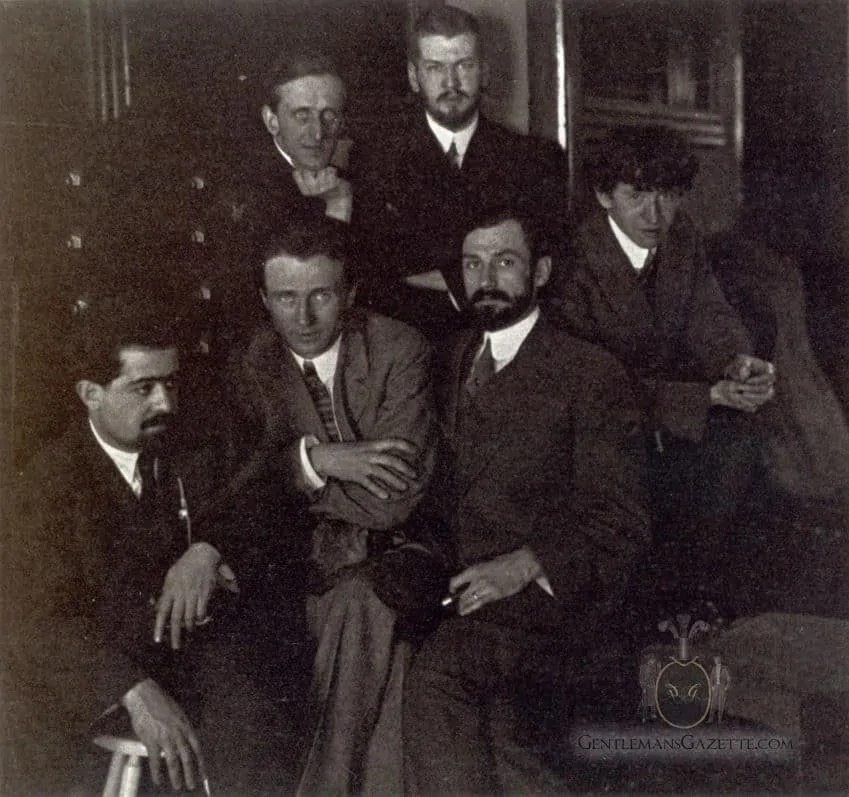
Last year, I profiled Leslie Saalburg and explained how these illustrations were created . Today, I want to focus on one of the most iconic men’s fashion illustrators and influencers from the 1930’s and 1940’s: Laurence Fellows (not Lawrence Fellows), whose work appeared in LIFE, Vanity Fair, Apparel Arts, and Esquire. He always signed with L. FELLOWS.
The Early Years
Fellows was born in Ardmore, Pennsylvania in 1885 and formally trained at the Pennsylvania Academy of Art. Subsequently, he developed his technique in England and specifically in France, where he worked under J.P. Laurens at the Academie Julien.
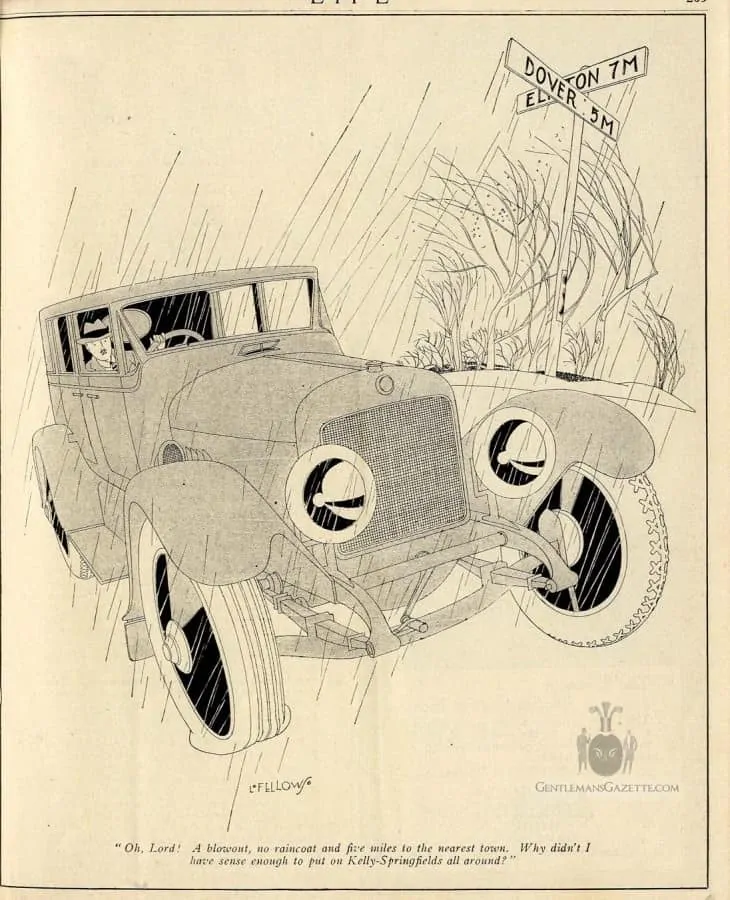
Upon his return to the US in 1910, Fellows became known for his Vogue-influenced drawing style that focused on shapes as a whole rather than on details. The thin outline and flat tonality were key features of his style at the time, which helped him land jobs with several satirical magazines.
Although his approach quickly attracted numerous imitators, Fellows’ preference for off-balanced compositions kept him a step ahead in terms of uniqueness, and he eventually attracted his first commercial client Kelly-Springfield Tires. Although advertising was rather conservative at the time, they provided him with the opportunity to combine his sophisticated draftsmanship with his humor and wit, sometimes coming close to breaking the rules against negative competitive advertising.
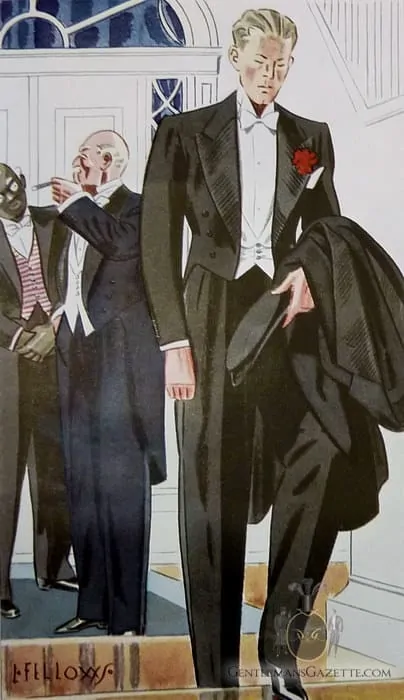
But take a look for yourself: the facial features in the drawings for LIFE do not lack detail but nevertheless, they are defined. There are no clouds or trees, just the main objects and of course, the Kelly Springfield brand name and a little praise for the brand underneath.
L. Fellows – Fashion Illustrator
In the 1930’s, L. Fellows realigned his focus away from this simplistic ad style to more detailed fashion illustrations. As such, he worked for magazine such as Vogue, Cosmopolitan, Vanity Fair, The American Magazine, and most importantly with Apparel Arts and Esquire magazine, which debuted in 1931 and 1933, respectively. Due to limited supply of male fashion artists, you could find at least one full page illustration by Laurence Fellows Fellows in almost every issue. Today, Fellows is most well known for the drawings from this decade, although he continued to work for Apparel Arts through the 1940’s.
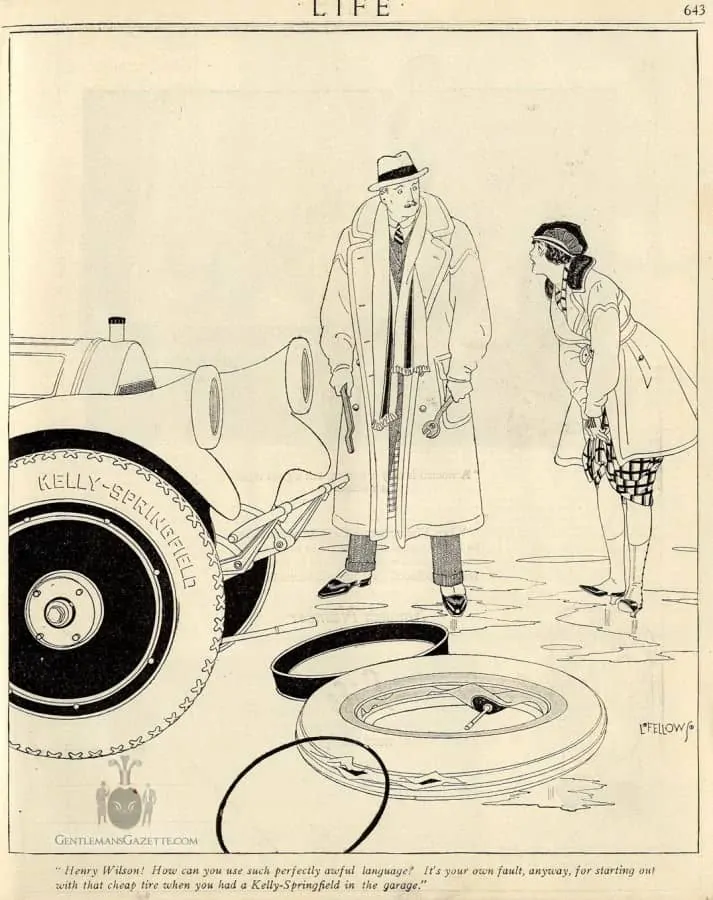
Early Work – Shape Over Detail
Over the years, I find the development in Fellows’ style quite remarkable.
As mentioned above, initially he was all about the drawing as a whole, not so much about the details. Just look at this pictures of a couple on an ocean steamer or how this man changes the tire. We can see the wingtip pattern on the shoes, the spats and the herringbone pattern on the pants, but the overcoat is reduced to essential lines. There is no background and even the car and the tires are rather minimalistic in their details.
The Fellows Man of Fashion
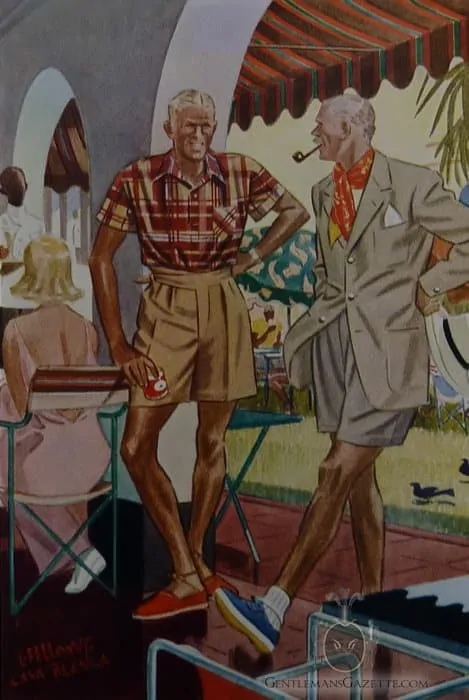
With the change in his style during the 1930’s, Fellows became more detail oriented and and had an overall more picturesque approach. His drawings were very stylized, which was well suited to portray the upcoming drape cut of the period’s men’s clothes.
Similarly to J.C. Leyendecker’s Arrow Collar Man, Fellows’ drawings became the epitome of the Man in Fashion in Apparel Arts and Esquire. The characters always looked dapper, affluent, sophisticated and unlike today, more seasoned. The Fellows Man of Fashionis probably in his early forties or fifties.
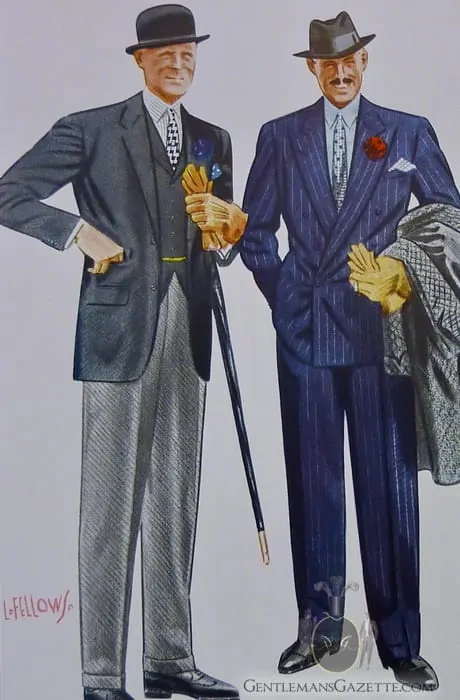
Now compare that to the Hackett and Ralph Lauren campaigns we recently discussed, or flip through any men’s fashion or lifestyle magazine – most of the fashionable men will be in their twenties.
Ironically, his very first fashion illustration in Apparel Arts appeared in spring 1933 and showed a young college student. Although younger than the average Fellows character, the man wears a full cut flannel three piece suit in mid grey with white chalk stripes, a demi Homburg, a blue shirt with white collar and cuffs as well as a checked tie. Overall, he looks much more like a gentleman rather than a college kid.
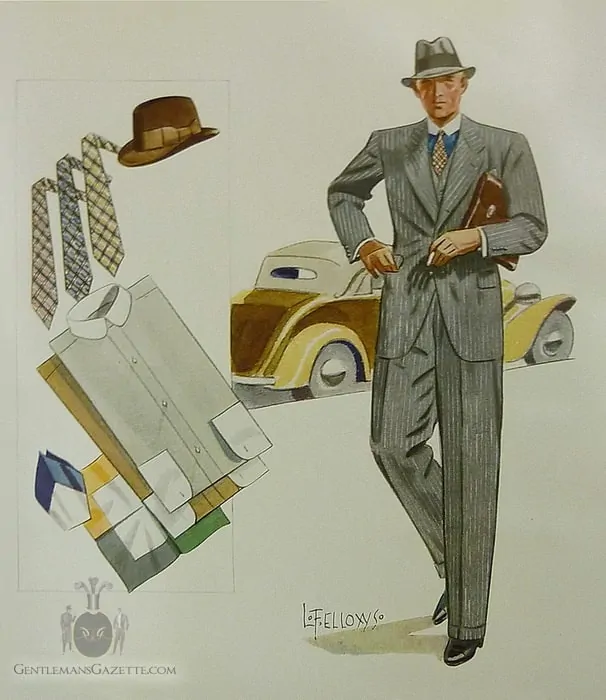
So, even though this man is not quite a true Fellows Man of Fashion, he certainly dresses like one – making him look well turned out and sophisticated.
The same is true for the two gentlemen in the white tie ensemble. Although different in age, they wear the same evening attire.
The men in Casablanca can afford to travel and look much more seasoned. Their clothes are obviously adapted to the warm climate, but still remain stylish. Wealth is expressed with their clothes, but also in the fact that they have the means to spend time abroad for relaxation.
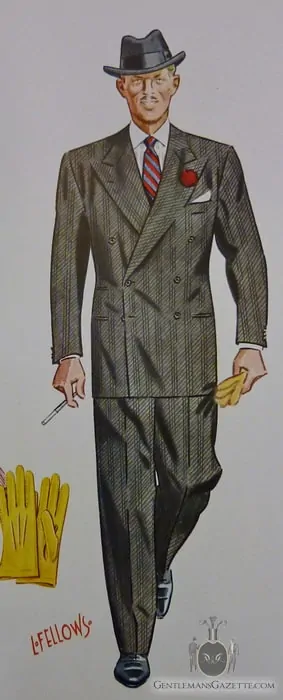
The picture of the two gentleman from 1938 displays the Fellows’ ideal chap: well dressed, elegant, but at the same time nonchalant. On the left, you can see a stroller suit with black bowler hat, Albert Chain, and tan gloves with an umbrella. On the right you can see a navy chalk stripe suit with a double breasted Kent Fasson, full cut trousers and chamois yellow gloves and hat.
The 1940’s
In the early 1940’s, his illustrations were still very much like in the late 1930’s.For example, compare the double breasted suits from 1939 to 1941. The trousers may be a little narrower, but the accessories are still the same and overall there is not much difference.
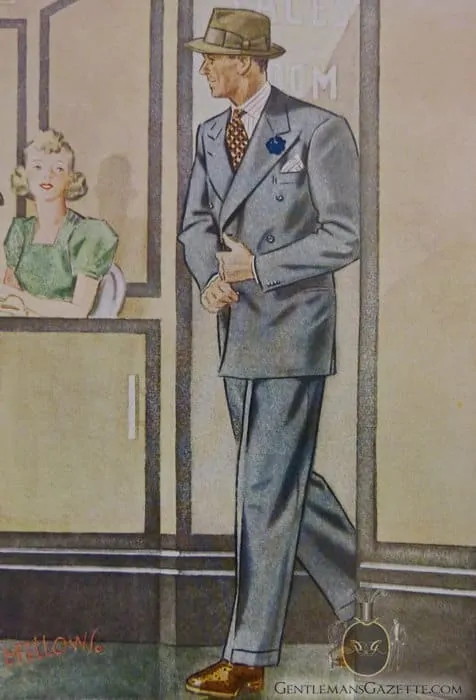
However, in 1944 Fellows reverted his style a little bit back to his earlier approach. The illustrations do not seem as detailed, and the color palette is more muted. With WWII, the glory and esprit of the 1930’s seems to have vanished in favor of a more subdued style.
For example, the jacket is single breasted, but made of a different cloth than the pants. The details in the drawing are less pronounced, but the trousers are narrower than in the mid 1930’s and due to cloth shortage during the war, cuffs were no longer worn. The shoes are not elegant anymore, but rather boxy and practical.
Fellows’ Impact
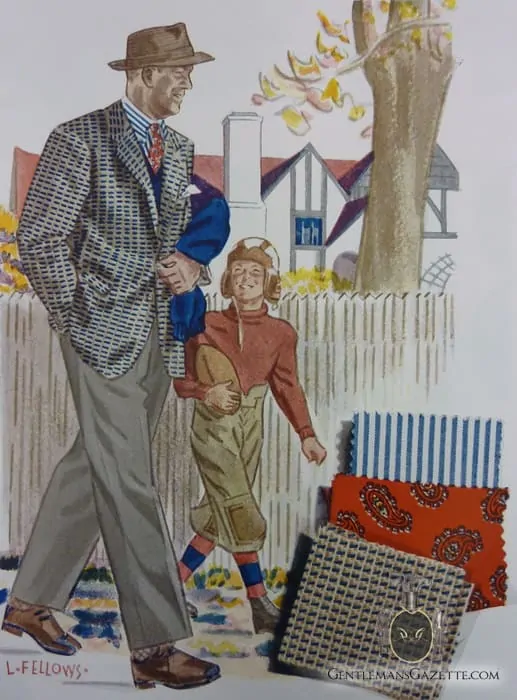
Laurence Fellows died in 1964. He was named to the Society of Illustrators Hall of Fame in 2009. He really understood how to use seasoned, authentic men to create an aspiration to be an affluent, elegant, yet relaxed gentleman who would live a sophisticated lifestyle.
His drawing technique and attention to details of fit and style aside, his greatest achievement was probably his ability to inspire men from around the world to dress more elegantly, even 60 years after his death.
If you are interested in more fashion illustrations from Laurence Fellows and others, you should take a peek at our category fashion illustrations.
Men’s Fashion Illustration Guide
That college-kid is really a nice demonstration of what it once meant to be in college. Nowadays even professors wearing a suit stand out.
Besides, I’m beginning to love the fashion of the 40’s more and more. At least this is true for the double-breasted suit from 1941. The narrower pants may serve as an example how a virtue is made out of necessity, in that case the shortage of fabric.
These are all excellent drawings, thanks a lot for sharing them.
Inspiring and essential. There is an absolute need for an integral compilation of the work Fellow’s and his peers displayed in Apparel Arts and Esquire, along with European magazines from the same era. Thank you, Sven.
Inspirational !!!